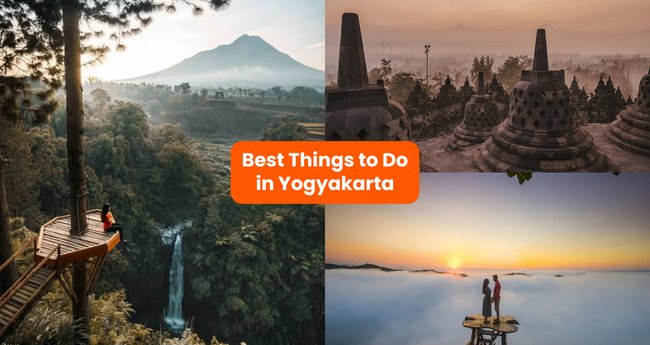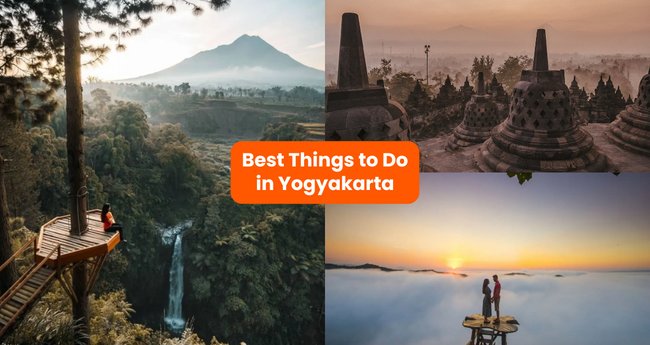
Yogyakarta, often affectionately shortened to "Yogya" or "Jogja," is more than just a city; it’s a living, breathing testament to Indonesia’s rich cultural heritage and vibrant spirit. Nestled on the island of Java, this special region, governed by its Sultan, stands as a beacon of traditional Javanese arts, history, and spirituality. From ancient temples that whisper tales of empires past to bustling markets overflowing with local crafts and delectable cuisine, Yogyakarta offers an immersive experience that captivates every traveler.
A Tapestry Woven with History:
Yogyakarta’s story is deeply intertwined with the rise and fall of Javanese kingdoms. Its origins can be traced back to the 18th century when Prince Mangkubumi, later Sultan Hamengkubuwono I, established the Sultanate of Ngayogyakarta Hadiningrat in 1755. This marked a significant shift in Javanese political landscape, creating a powerful Javanese state that would influence the region for centuries. The city itself was meticulously planned, with the Sultan’s Palace (Keraton) at its heart, surrounded by key religious and administrative buildings, a testament to Javanese cosmology and architectural principles.
Related Articles about Yogyakarta: A Journey Through Java’s Soul and Enchantment:
- Egypt: A Journey Through Time, Wonder, and Unforgettable Experiences
- Hungary: A Tapestry of History, Culture, and Unforgettable Experiences
- Chile: A Land of Extremes and Unforgettable Adventures
- Bali: A Traveler’s Guide to the Island of Gods
- Singapore’s Irresistible Charms: A Comprehensive Guide to the Lion City’s Best Tourist Attractions
Beyond the Sultanate, Yogyakarta holds a special place in Indonesia’s modern history. During the Indonesian National Revolution, it served as the temporary capital of the Republic of Indonesia from 1946 to 1949. This period solidified its reputation as a stronghold of Indonesian independence and nationalism, a legacy that continues to resonate within its cultural fabric. The spirit of resistance and resilience is palpable, adding another layer of depth to its historical significance.
Main Attractions: Unveiling Yogya’s Treasures:
Yogyakarta’s allure lies in its diverse array of attractions, catering to history buffs, spiritual seekers, art enthusiasts, and adventure lovers alike.
-
The Majestic Keraton (Sultan’s Palace): The undisputed heart of Yogyakarta, the Keraton is a sprawling complex that offers a glimpse into the lives of the royal family and the intricacies of Javanese court culture. Wander through its courtyards, marvel at the traditional architecture, and witness captivating cultural performances like gamelan music and Javanese dance. The palace museum houses an impressive collection of royal artifacts, offering insights into the Sultanate’s history and traditions. Don’t miss the opportunity to see the Sultan himself, who occasionally holds audiences with visitors.
-
Taman Sari (Water Castle): Located just west of the Keraton, Taman Sari is a fascinating complex of former royal gardens, bathing pools, and underground tunnels. Built in the mid-18th century as a pleasure ground and defensive fortress, it’s a romantic and intriguing place to explore. Imagine the sultans and their consorts enjoying leisurely days amidst the lush greenery and serene waters. The underground mosque, a unique architectural feature, is particularly noteworthy.
-
Borobudur Temple: A UNESCO World Heritage site and one of the world’s largest Buddhist temples, Borobudur is an absolute must-visit. Located about an hour’s drive from Yogyakarta, this colossal monument dates back to the 9th century and is a masterpiece of Mahayana Buddhist architecture. Its intricately carved reliefs depict Buddhist teachings, the life of Buddha, and scenes from daily life in ancient Java. Witnessing sunrise or sunset from the top of Borobudur, with the mist rising from the surrounding valleys, is an unforgettable spiritual and visual experience.
-
Prambanan Temple: Another UNESCO World Heritage site, Prambanan is the largest Hindu temple complex in Indonesia, dedicated to the Trimurti – Brahma, Vishnu, and Shiva. Built in the 9th century, its towering spires and intricate carvings are a testament to the grandeur of ancient Javanese Hinduism. The Roro Jonggrang legend, associated with the tallest temple, adds a mythical dimension to its appeal. The Ramayana ballet performed at Prambanan during full moon nights is a spectacular cultural event.
-
Malioboro Street: The pulsating artery of Yogyakarta, Malioboro Street is a vibrant and bustling thoroughfare teeming with life. This iconic street is a sensory overload, with countless street vendors selling everything from traditional batik clothing and handicrafts to local snacks and souvenirs. It’s the perfect place to soak in the local atmosphere, haggle for treasures, and sample street food. As evening descends, Malioboro transforms into a lively hub with street performers and a myriad of dining options.
-
Mount Merapi: For the adventurous, a visit to Mount Merapi, one of Indonesia’s most active volcanoes, is a thrilling experience. You can opt for a jeep tour that takes you through lava fields and villages affected by past eruptions, offering a stark reminder of nature’s power. For the truly daring, a guided hike to the crater rim (depending on volcanic activity) provides breathtaking panoramic views.
-
Ullen Sentalu Museum: Tucked away in the cooler highlands of Kaliurang, this exquisite museum offers a unique and intimate glimpse into Javanese royal life and culture, specifically focusing on the royal families of Yogyakarta and Surakarta. It houses a collection of artifacts, photographs, and traditional attire, presented in a beautifully curated and informative manner.
Travel Tips for a Seamless Yogya Adventure:
- Currency: The Indonesian Rupiah (IDR) is the official currency. ATMs are widely available, and credit cards are accepted in most hotels and larger establishments.
- Language: Bahasa Indonesia is the official language, but English is widely spoken in tourist areas. Learning a few basic Indonesian phrases will be appreciated by the locals.
- Etiquette: Dress modestly when visiting religious sites and the Keraton, covering shoulders and knees. It’s customary to remove your shoes before entering temples and homes.
- Bargaining: Bargaining is expected in markets and with street vendors. Approach it with a smile and respect.
- Hydration: The tropical climate can be warm and humid. Drink plenty of water to stay hydrated.
- Sun Protection: Pack sunscreen, a hat, and sunglasses to protect yourself from the sun.
- Respect for Culture: Be mindful of local customs and traditions. Ask for permission before taking photos of people.
Best Time to Visit Yogyakarta:
Yogyakarta experiences a tropical climate with two main seasons:
-
Dry Season (April to October): This is generally considered the best time to visit. The weather is sunny and pleasant, with lower humidity and less rainfall, making it ideal for outdoor exploration and temple visits.
-
Wet Season (November to March): This period brings heavier rainfall, often in short, intense bursts, followed by sunshine. While it can be more humid, the landscapes are lush and vibrant, and you might find fewer crowds. The occasional rain shower shouldn’t deter you from visiting, as attractions are still accessible, and the experience can be equally rewarding.
Where to Stay: Cozy Havens and Luxurious Retreats:
Yogyakarta offers a wide range of accommodation options to suit every budget and preference:
-
Luxury Hotels: For a pampered experience, consider hotels like The Phoenix Hotel Yogyakarta, a beautifully restored colonial building, or Hyatt Regency Yogyakarta, offering lush gardens and excellent amenities. Grand Mercure Yogyakarta provides modern comfort and convenience.
-
Mid-Range Hotels: Travelers seeking comfort and value will find excellent options like Greenhost Boutique Hotel with its unique eco-friendly design, Adhisthana Hotel for its stylish rooms and central location, and ARTOTEL Yogyakarta for its artistic ambiance.
-
Boutique and Budget-Friendly Stays: Yogyakarta is renowned for its charming boutique guesthouses and budget-friendly hotels. Look for places in the Prawirotaman or Sosrowijayan areas, offering characterful rooms and a welcoming atmosphere. Via Via Traveler’s Hostel is a popular backpacker choice.
A Culinary Journey: Savoring Yogya’s Flavors:
Yogyakarta’s food scene is as rich and diverse as its culture. Prepare your taste buds for an explosion of flavors:
-
Gudeg: The quintessential Yogya dish, Gudeg is young jackfruit stewed in coconut milk and palm sugar for hours until it becomes tender and sweet. It’s often served with rice, chicken, egg, and krecek (spicy beef skin crackers). Try it at Gudeg Yu Djum or Gudeg Pawon.
-
Nasi Goreng: While found throughout Indonesia, Yogya’s nasi goreng often has its own unique twist. Look for variations like Nasi Goreng Mawut (fried rice with noodles) or Nasi Goreng Gila (crazy fried rice with various toppings).
-
Sate Klathak: This unique satay is made with skewers of lamb or goat meat, grilled over charcoal and seasoned with a simple but delicious spice blend. It’s often served with a savory broth. Sate Klathak Pak Pong is a legendary spot.
-
Bakpia Pathok: These small, round sweet pastries are a popular souvenir and snack. They come with various fillings, including green bean, chocolate, and cheese. You’ll find numerous bakpia shops, with Bakpia Pathok 25 being a well-known brand.
-
Jajan Pasar: These are traditional Indonesian snacks, often sweet and colorful, sold at local markets. Don’t miss trying klepon (glutinous rice balls with palm sugar filling), putu ayu (steamed cakes), and lapis legit (layered cake).
Getting Around: Navigating Yogyakarta with Ease:
Yogyakarta offers several convenient transportation options:
-
Becak (Pedicab): A charming and traditional mode of transport, becaks are perfect for short distances and for experiencing the local vibe. Agree on the price beforehand.
-
Andong (Horse-drawn Carriage): Similar to becaks, andongs offer a more leisurely and romantic way to explore the city, especially around the Keraton and Malioboro.
-
Taxis and Ride-Hailing Apps: Reliable metered taxis are readily available. Ride-hailing apps like Grab and Gojek are also very popular and offer a convenient and often cheaper alternative for getting around.
-
Rental Motorbikes/Scooters: For independent exploration, renting a motorbike is a popular choice. Ensure you have an international driving permit and always wear a helmet.
-
Buses: TransJogja buses operate on dedicated lanes and are an affordable way to travel between major points in the city.
-
Car Rental: For day trips to Borobudur or Prambanan, renting a car with a driver can be a comfortable and efficient option.
Yogyakarta is a city that unfolds its magic gradually, revealing layers of history, spirituality, and vibrant life with every step. From the grandeur of its ancient temples to the warmth of its people and the tantalizing flavors of its cuisine, this Javanese gem promises an unforgettable journey that will linger in your heart long after you depart. So, pack your bags, embrace the adventure, and let Yogyakarta’s soul enchant you.








